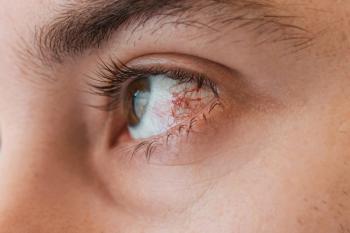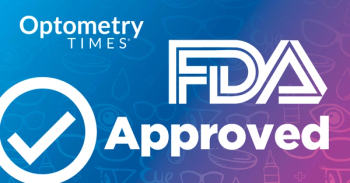
- June digital edition 2022
- Volume 14
- Issue 6
Identifying patients with keratoconus
Early diagnosis enables cross-linking treatment before significant vision loss.
Keratoconus (KC) affects approximately 1 in 2000 individuals, with the prevalence of the disease possibly higher in certain populations.1-3 Younger patients progress more rapidly,4,5 so it is important that eye care practitioners are particularly alert to the potential for KC in young patients and prepared to refer them for further evaluation and treatment.
As gatekeepers to the young vision-corrected population, optometrists are on the front lines of KC diagnosis and referrals—a role that can have life-changing implications for our patients.
Related:
Using a simulation model, researchers have shown that treatment with the FDA-approved cross-linking procedure iLink (Glaukos Corporation) could reduce the time patients spend in the advanced stages of KC by 28 years, lower the rate of penetrating keratoplasty by 26%, and contribute to a lifetime cost savings of $43,759 per patient.6
Red flags
Be aware of 4 red flags when screening patients for KC:
1. Failure of a young patient (< age 30 years) to correct to 20/20 in at least 1 eye, unless the limited best-corrected vision can be explained by some other ocular pathology
2. A change in astigmatism of greater than
1.0 diopter (D), even if the patient is still
correctable to 20/20
3. A personal history of eye rubbing
4. A family history of KC
If any of these red flags are present—and especially if I see more than one of them—the next step should be topography. On topography, I look for greater than 2.0 D
inferior-to-superior asymmetry, central steepening of greater than 2.0 D, or mean topographical keratometry greater than 47 D.
It is important to look at the absolute dioptric values, not just the topography map, because color scales are not always standardized. What looks like a red “hot spot” may actually be an artefact if the dioptric value within the area is lower than the color would normally indicate.
In patients with worse than 20/20 best-corrected vision and irregularities on topography, a good slit lamp exam is also needed to ensure that other conditions (such as dry eye, meibomian gland dysfunction [MGD], or a corneal scar) aren’t masquerading as KC.
Related:
Although this is somewhat unusual, I have seen highly suspicious corneas become totally normal once the ocular surface was treated appropriately.
Eyes with suspicious topography should be monitored every 3 to 6 months—and potentially even more frequently in young patients2—to determine whether there is any progression of topographical signs and then referred right away for a cross-linking evaluation once progressive KC is diagnosed or strongly suspected.
Given the availability of an FDA-approved treatment that can actually slow or halt KC progression, it is no longer clinically appropriate just to manage patients’ vision and ignore the degenerative aspect of their condition until they can no longer be fit with
In fact, delaying care could expose one to legal liability. Rigid gas-permeable or scleral lenses may be needed to obtain the patient’s best vision, both before and after cross-linking, but they do not slow or cease disease progression in the way that cross-linking does.
For practices that don’t have a topography device, performing retinoscopy to determine whether there is a normal reflex versus a scissor reflex or Charleaux (“oil droplet”) sign is another useful tool.
In addition to retinoscopy and the 4 clinical red flags, clinicians should perform a very careful slit lamp exam to see if there is any inferior corneal thinning or an inferior “iron line.”
Related:
If the findings continue to be concerning or there are multiple red flags, refer the patient out for topography.
I have a very low threshold for performing topography because it is an easy, noninvasive test that doesn’t take much time to do.
Although it is true that a topography exam with normal findings may not be reimbursed, I would much rather absorb the cost of some unreimbursed imaging than miss a diagnosis and unnecessarily delay treatment for the patient.
Ultimately, in my experience, this type of best practice–oriented care is what it takes to earn patient loyalty and develop long-term patient retention.
Topography should top your wish list
Historically, many optometric practices have not offered topography, but the technology is becoming both more accessible and affordable—and also more critical to full-scope practice.
Optometrists may be pleasantly surprised at how many different medical diagnoses justify topography.
Many insurance companies will reimburse for topography when it is used to evaluate irregular astigmatism, ectasia, corneal dystrophies, pterygia, corneal scars, and other corneal pathology.
Glaukos and Topcon Healthcare have a partnership program that can lower the cost of entry for practices that are considering acquiring topography.
Topography is also very useful for anyone comanaging laser corneal surgery or cataract surgery. Intraocular lens power calculations can vary dramatically with either dry eye or anterior basement membrane dystrophy—and 1 or both of those conditions are present in a significant percentage of the geriatric population with cataract.
Related: Share care of the ocular surface before and after cataract surgery
Referring optometrists who establish a healthy medical practice with topography will also be able to provide top-of-the-line care in preparing patients for cataract surgery and screening out those who are poor candidates for laser refractive surgery.
Even for primarily vision care–oriented practices, topography can still be useful. Not only will it facilitate early identification of KC, but it can aid in
sizing and fitting rigid or scleral lenses and even in understanding why otherwise routine toric contact lens fits may be particularly challenging.
A combination autorefractor/topographer may be a good choice for practices that are short on space or need any new diagnostic equipment to do double duty.
Many resources are available for learning to interpret topography and distinguish normal, suspicious, and clearly keratoconic maps (see Figure).
One of the best options for optometrists who already refer patients for laser vision correction may be to spend a couple of hours at the LASIK center, learning how the clinicians there evaluate topographies.
Although there are many nuances, paying close attention to the simple dioptric guideposts I mentioned at the beginning of this article is a helpful start.
We are fortunate to have these excellent diagnostic tools, and it is very rewarding to use them to catch progressive KC cases early and be able to offer cross-linking treatment before patients lose significant vision.
References
1. Chan E, Chong EW, Lingham G, et al. Prevalence of keratoconus based on Scheimpflug imaging: the Raine Study. Ophthalmology. 2021;128(4):515-521. doi:10.1016/j.ophtha.2020.08.020
2. Godefrooij DA, de Wit GA, Uiterwaal CS, Imhof SM, Wisse RP. Age-specific incidence and prevalence of keratoconus: a nationwide registration study. Am J Ophthalmol. 2017;175:169-172. doi:10.1016/j.ajo.2016.12.015
3. Torres Netto EA, Al-Otaibi WM, Hafezi NL, et al. Prevalence of keratoconus in paediatric patients in Riyadh, Saudi Arabia. Br J Ophthalmol. 2018;102(10):1436-1441. doi:10.1136/bjophthalmol-2017-311391
4. Ferdi AC, Nguyen V, Gore DM, Allan BD, Rozema JJ, Watson SL. Keratoconus natural progression: a systematic review and meta-analysis of 11,529 eyes. Ophthalmology. 2019;126(7):935-945. doi:10.1016/j.ophtha.2019.02.029
5. Romano V, Vinciguerra R, Arbabi EM, et al. Progression of keratoconus in patients while awaiting corneal cross-linking: a prospective clinical study. J Refract Surg. 2018;34(3):177-180. doi:10.3928/1081597X-20180104-01
6. Lindstrom RL, Berdahl JP, Donnenfeld ED, et al. Corneal cross-linking versus conventional management for keratoconus: a lifetime economic model. J Med Econ. 2021;24(1):410-420. doi:10.1080/13696998.2020.1851556
Articles in this issue
over 3 years ago
Happy accidents vs planning for success: part 1over 3 years ago
4 ways to maximize success with multifocal contact lensesover 3 years ago
Peripupillary prognosticators of glaucomaover 3 years ago
Therapy options based on DED severityover 3 years ago
Digital health care in optometryover 3 years ago
Advances in the management of dry AMDNewsletter
Want more insights like this? Subscribe to Optometry Times and get clinical pearls and practice tips delivered straight to your inbox.








































